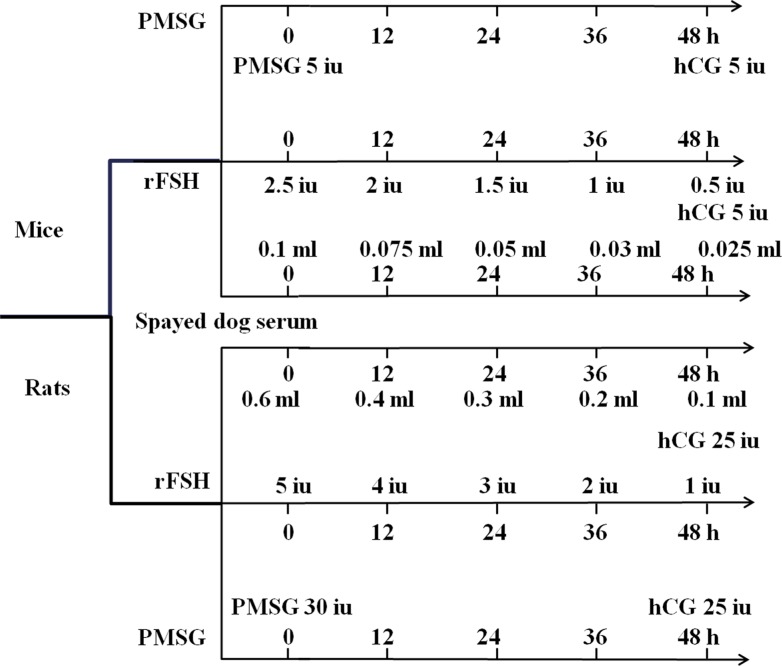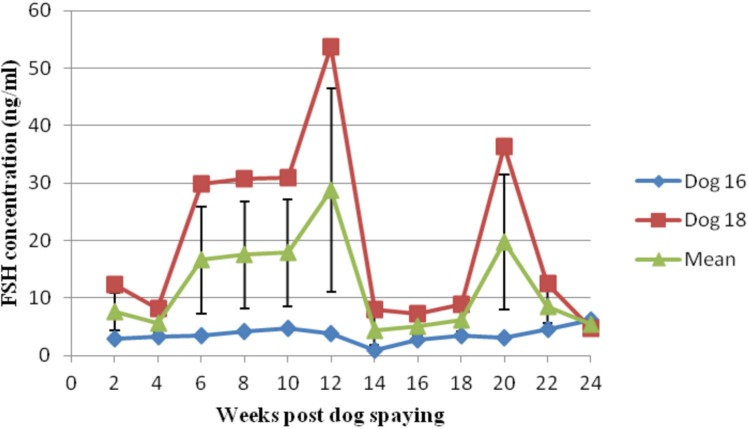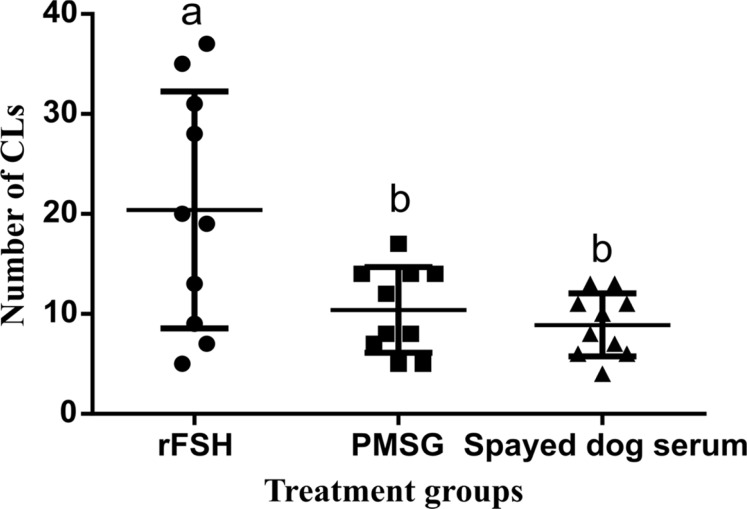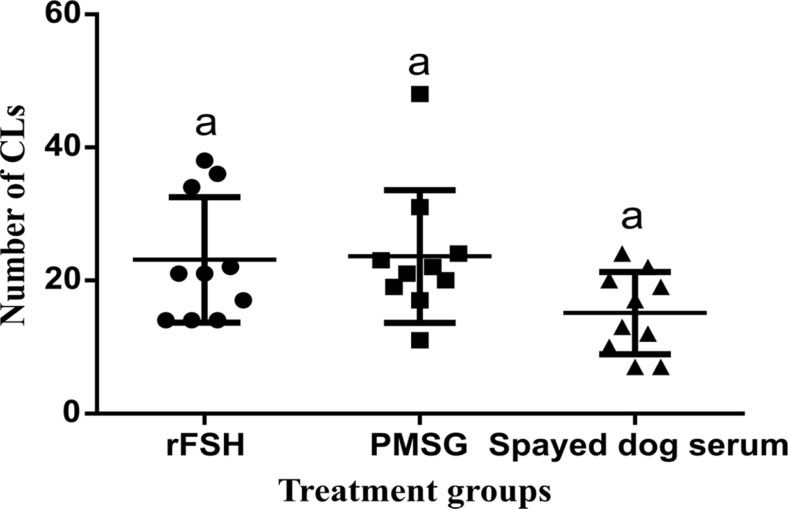Lab Anim Res.
2018 Dec;34(4):211-215. 10.5625/lar.2018.34.4.211.
Induction of superovulation in mature mice and rats using serum of spayed female dogs
- Affiliations
-
- 1Department of Clinical Sciences, School of Veterinary Medicine, Shiraz University, Shiraz, Iran. mogheiseh@yahoo.com
- 2Gastrointestinal and Liver Diseases Research Center, Gilan University of Medical Sciences, Rahst, Iran.
- KMID: 2459297
- DOI: http://doi.org/10.5625/lar.2018.34.4.211
Abstract
- The following experiments were designed to examine the effect of serum of spayed dogs on superovulation response in mice and rats. In Experiment 1, female mice at diestrus (n=30) were divided into three equal groups and superovulated with either administration of 5 IU pregnant mare serum gonadotropin (PMSG) or recombinant follicle stimulating hormone (rFSH) (reducing dose from 2.5 to 0.5 IU) and 5 IU human chorionic gonadotropin (hCG) administered 48h later. Serum of spayed dogs was administered intraperitoneally at a reduced dose from 0.1 to 0.025 mL in a 48 h period. In Experiment 2, female rats (n=30) at diestrus stage were divided into three equal groups. Superovulation was induced using either 30 IU PMSG, or a dose reduced from 5 to 1 IU rFSH and 25 IU hCG administered 48h later. Serum of spayed dogs was administered in a reduced dose from 0.6 to 0.1 mL in a 48 hour period. Female mice and rats were mated 24 h following hCG administration. On day 14 after mating, animals were euthanized and ovarian sections were fixed for histopathological evaluation and corpus luteum (CL) counting. No significant difference observed in mean (±SEM) number of CLs between the PMSG group and the mice that received serum of spayed dog (10.4±1.3 vs 9.2±1.0). Mean (±SEM) number of CLs tended to be lower in rats that received serum of spayed dog than those of rats which received either PMSG or rFSH (15.1±1.9 vs 23.6±3.1 and 23.1±2.9, P=0.06, respectively). In conclusion, serum of spayed dogs is able to induce a superovulatory response in mice and rats.
Keyword
MeSH Terms
Figure
Reference
-
1. Albers-Wolthers CH, de Gier J, Oei CH, Schaefers-Okkens AC, Kooistra HS. Validation of a noninvasive diagnostic tool to verify neuter status in dogs: The urinary FSH to creatinine ratio. Theriogenology. 2016; 86(5):1376–1381. PMID: 27242177.
Article2. Beijerink NJ, Buijtels JJ, Okkens AC, Kooistra HS, Dieleman SJ. Basal and GnRH-induced secretion of FSH and LH in anestrous versus ovariectomized bitches. Theriogenology. 2007; 67(5):1039–1045. PMID: 17275081.
Article3. Boland MP, Goulding D, Roche JF. Alternative gonadotrophins for superovulation in cattle. Theriogenology. 1991; 35(1):5–17.
Article4. Hasegawa A, Mochida K, Inoue H, Noda Y, Endo T, Watanabe G, Ogura A. High-Yield Superovulation in Adult Mice by Anti-Inhibin Serum Treatment Combined with Estrous Cycle Synchronization. Biol Reprod. 2016; 94(1):21. PMID: 26632610.
Article5. Hoppen HO. The equine placenta and equine chorionic gonadotrophin--an overview. Exp Clin Endocrinol. 1994; 102(3):235–243. PMID: 7995345.6. Ishigame H, Medan MS, Kawaguchi M, Fukuda A, Watanabe G, Arai KY, Taya K. Induction of superovulation by immunoneutralization of endogenous inhibin in immature rats. J Reprod Dev. 2005; 51(5):559–566. PMID: 16034198.
Article7. Kanitz W, Becker F, Schneider F, Kanitz E, Leiding C, Nohner HP, Pöhland R. Superovulation in cattle: practical aspects of gonadotropin treatment and insemination. Reprod Nutr Dev. 2002; 42(6):587–599. PMID: 12625423.
Article8. Leão Rde B, Esteves SC. Gonadotropin therapy in assisted reproduction: an evolutionary perspective from biologics to biotech. Clinics (Sao Paulo). 2014; 69(4):279–293. PMID: 24714837.9. Ludwig M, Westergaard LG, Diedrich K, Andersen CY. Developments in drugs for ovarian stimulation. Best Pract Res Clin Obstet Gynaecol. 2003; 17(2):231–247. PMID: 12758097.
Article10. Luo C, Zuñiga J, Edison E, Palla S, Dong W, Parker-Thornburg J. Superovulation strategies for 6 commonly used mouse strains. J Am Assoc Lab Anim Sci. 2011; 50(4):471–478. PMID: 21838974.11. Mukumoto S, Mori K, Ishikawa H. Efficient induction of superovulation in adult rats by PMSG and hCG. Exp Anim. 1995; 44(2):111–118. PMID: 7601219.
Article12. Olson PN, Mulnix JA, Nett TM. Concentrations of luteinizing hormone and follicle-stimulating hormone in the serum of sexually intact and neutered dogs. Am J Vet Res. 1992; 53(5):762–766. PMID: 1524303.13. Reichler IM. Gonadectomy in cats and dogs: a review of risks and benefits. Reprod Domest Anim. 2009; 44(Suppl 2):29–35. PMID: 19754532.
Article14. Santoro N, Randolph JF Jr. Reproductive hormones and the menopause transition. Obstet Gynecol Clin North Am. 2011; 38(3):455–466. PMID: 21961713.
Article
- Full Text Links
- Actions
-
Cited
- CITED
-
- Close
- Share
- Similar articles
-
- The Clinical Significance of Serum Vascular Endothelial Growth Factor Levels Measured at Ovulation Triggering Day in Intrauterine Insemination Cycles
- Super pregnancy in a BALB/c mouse superovulated with PMSG
- Experimental infection of Paragonimus westermani in mice and rats
- Studies on intestinal trematodes in Korea IX. Recovery rate and development of Fibricola seoulensis in experimental animals
- Clinical Study of Intrauterine Insemination following Clomiphene/hMG Combined Superovulation in Infertile Couples





